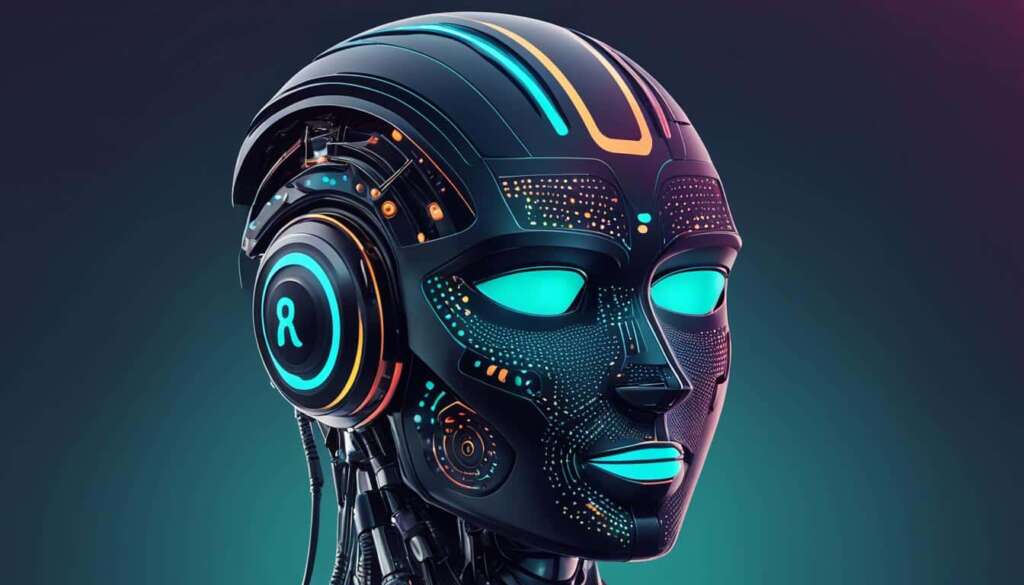Table of Contents
AI chatbots have revolutionized the way we interact with technology. One notable example is ChatGPT, an artificial intelligence-powered conversational chatbot developed by OpenAI. Utilizing advanced techniques such as natural language processing and generative AI, ChatGPT is at the forefront of AI-driven conversational interfaces.
ChatGPT is built upon the foundation of GPT-3, which stands for Generative Pre-trained Transformer. This cutting-edge technology enables ChatGPT to process and respond to user requests using machine learning algorithms. Through reinforcement learning and human feedback, ChatGPT continuously refines its responses, ensuring an ever-improving conversational experience.
With its ability to understand and generate humanlike dialogue, ChatGPT is incredibly versatile. It can generate written content for various purposes, including articles, social media posts, emails, and code. This makes ChatGPT a valuable tool for writers, developers, and individuals seeking assistance in their day-to-day tasks.
Whether you need help in STEM disciplines, code debugging, music composition, or even quantum computing explanations, ChatGPT is ready to lend a virtual hand. It offers multilingual support and can assist in tasks ranging from trivia questions to job searches.
However, while ChatGPT provides numerous benefits, it also has its limitations and ethical concerns. Its understanding of complex human language is still evolving, and accuracy can vary. Responsible usage, addressing issues such as bias, plagiarism, privacy, and security, must be prioritized in deploying AI technologies like ChatGPT.
In the next sections, we will delve deeper into how ChatGPT works, the scope of its capabilities, and the potential benefits and concerns associated with its use. Join us as we uncover the fascinating world of AI chatbots and their impact on our lives.
How does ChatGPT work?
ChatGPT utilizes the power of the Generative Pre-trained Transformer (GPT) to function as an advanced AI chatbot. Originally trained with the GPT-3 large language model, it has since evolved to leverage the GPT-3.5 model and the advanced GPT-4 model in its premium version, ChatGPT Plus. This sophisticated architecture is built on the foundation of deep learning and transformer neural networks, enabling ChatGPT to generate text that closely resembles human language and conversation.
At its core, ChatGPT is trained using a vast amount of training data that includes generic text as well as conversations and transcripts. By learning from a wide range of sources, ChatGPT gains a solid understanding of human language and the intricacies of conversation. The training process involves exposing the model to different patterns and sequences in the data to predict the next word in a sentence, allowing for accurate next word prediction.
During the training process, human trainers are instrumental in further refining ChatGPT’s capabilities. These trainers provide conversations and rank potential responses, empowering the model to learn from human expertise and improve its future responses. The ranked responses are vital for reinforcement learning, where user feedback plays a crucial role.
ChatGPT incorporates feedback mechanisms such as upvotes, downvotes, and written feedback from users. These feedback loops enable continuous improvement of the model’s performance and help align its responses with user expectations. By incorporating reinforcement learning and integrating human trainers and user feedback, ChatGPT continually refines its abilities to offer more accurate and contextually appropriate responses.
Overall, ChatGPT showcases the immense potential of deep learning and transformer neural networks in the field of natural language processing. Its training regime merges the power of large language models, human trainers, and user feedback to create a sophisticated conversational AI capable of generating humanlike text.
Training Data and Reinforcement Learning
ChatGPT leverages a vast amount of training data to develop its language understanding and conversational abilities. This data includes a wide variety of text sources, conversations, and transcripts. By training on diverse datasets, ChatGPT gains a comprehensive understanding of human language patterns and context.
The deep learning aspect of ChatGPT’s transformer neural network allows it to analyze and learn from the training data to predict the most appropriate next word in a given context. This enables ChatGPT to generate coherent and contextually relevant responses during conversations.
The involvement of human trainers is another critical aspect of ChatGPT’s training process. These trainers provide conversations and rank potential responses, helping to fine-tune the model’s understanding of conversational dynamics and improve the quality of its generated responses.
Reinforcement learning also plays a crucial role in ChatGPT’s training. User feedback, in the form of upvotes, downvotes, and written feedback, helps the model learn from its mistakes and adjust its response generation accordingly. This constant feedback loop enables ChatGPT to continually improve and enhance its conversational abilities over time.
What can users ask ChatGPT?
ChatGPT is designed to assist users in a wide range of tasks and answer various types of questions. Whether you need help with STEM disciplines, code debugging, music composition, email drafting, article summarization, social media scripting, math problem solving, content rewording, job searches, trivia questions, or art generation, ChatGPT has got you covered. Its versatility extends to explaining complex topics such as quantum computing in simpler terms, making it a valuable resource for learners and professionals alike.
Notably, ChatGPT’s capabilities span a broad spectrum, allowing users to engage in conversation and seek additional information or alternative responses. There are no specific limitations on the types of queries or requests users can make, empowering them to explore various domains and receive valuable assistance.
Examples of Queries and Requests:
“Can you help me debug my code for a Python project?”
“I’m composing a piece of music. Can you provide suggestions for harmonies?”
“I need help drafting a professional email. Can you assist me?”
“Can you summarize this article about quantum physics?”
“I want to draft an engaging social media script. Any tips?”
“How do I solve this complex math problem involving differential equations?”
“Can you help reword this content to enhance its clarity?”
“I’m looking for job search advice tailored to the tech industry.”
“Can you provide me with trivia questions about famous historical events?”
“Generate an art piece inspired by abstract expressionism.”
These examples demonstrate the diverse range of tasks and inquiries that users can confidently approach ChatGPT with. Its vast knowledge and understanding can provide invaluable support across various domains, ensuring users receive accurate and helpful information.

| Domain | Assistance Capability |
|---|---|
| STEM disciplines | Code debugging, math problem solving, quantum computing explanation |
| Music composition | Harmony suggestions, music-related queries |
| Email drafting | Professional email composition guidance |
| Article summarization | Summarizing text content |
| Social media scripting | Creating engaging scripts for social media content |
| Content rewording | Enhancing clarity and style of text |
| Job searches | Job search advice tailored to specific industries |
| Trivia questions | Providing trivia questions on various topics |
| Art generation | Creating unique art pieces based on given parameters |
Benefits, Limitations, and Ethical Concerns of ChatGPT
ChatGPT offers numerous benefits that make it a valuable tool in various domains. Firstly, it enhances efficiency by handling routine tasks, saving time and resources. Additionally, it enables significant cost savings compared to hiring additional employees for similar tasks. Moreover, ChatGPT contributes to content quality improvement through advanced grammar and language enhancement, ensuring professional-grade output.
Furthermore, ChatGPT serves as an educational resource, acting as a virtual tutor across a wide range of subjects. Its instant response time and continuous availability make it highly reliable for users seeking immediate assistance. The chatbot also provides multilingual support, catering to a diverse audience worldwide.
Personalization is another key strength of ChatGPT, with the ability to tailor responses to individual preferences. It offers scalability to handle high user engagement, ensuring a seamless experience for all users. Additionally, ChatGPT demonstrates natural language understanding, allowing it to generate contextually relevant and meaningful responses.
However, it is important to note certain limitations and ethical concerns. Although ChatGPT excels in many areas, it may struggle to fully comprehend complex human language and lacks knowledge beyond 2021 data. Accuracy may vary, and responses may occasionally sound computer-generated or unnatural. It is crucial to address ethical concerns related to potential bias, plagiarism, privacy, and security, as well as consider the responsible usage of AI technologies.
FAQ
What is ChatGPT?
ChatGPT is an AI chatbot developed by OpenAI. It is an artificial intelligence program that uses natural language processing to generate humanlike conversational dialogue. The name “GPT” stands for “Generative Pre-trained Transformer,” which refers to the way ChatGPT processes requests and formulates responses.
How does ChatGPT work?
ChatGPT works using a Generative Pre-trained Transformer, which is a neural network machine learning model. It has been trained with the GPT-3.5 and GPT-4 models in ChatGPT Plus. The transformer utilizes deep learning techniques to predict text based on patterns and sequences in its training data. Human trainers provide conversations and rank the responses, helping to improve the model’s future responses. Reinforcement learning with user feedback is also incorporated for continuous improvement.
What can users ask ChatGPT?
Users can ask ChatGPT a wide variety of questions and request assistance with different tasks. It is proficient in STEM disciplines and can help with code debugging, math problems, and explaining complex topics such as quantum computing. It can also assist with music composition, email drafting, social media scripting, job searches, trivia questions, art generation, and more.
What are the benefits, limitations, and ethical concerns of ChatGPT?
ChatGPT offers several benefits, including increased efficiency, cost savings, improved content quality, educational support, instant response time, continuous availability, multilingual support, personalized responses, scalability, and natural language understanding. However, it has limitations such as accuracy variations, machine-generated responses, and lack of knowledge beyond 2021 data. There are also ethical concerns regarding potential misuse, plagiarism, privacy, security, and bias in the training data and outputs generated by ChatGPT.







